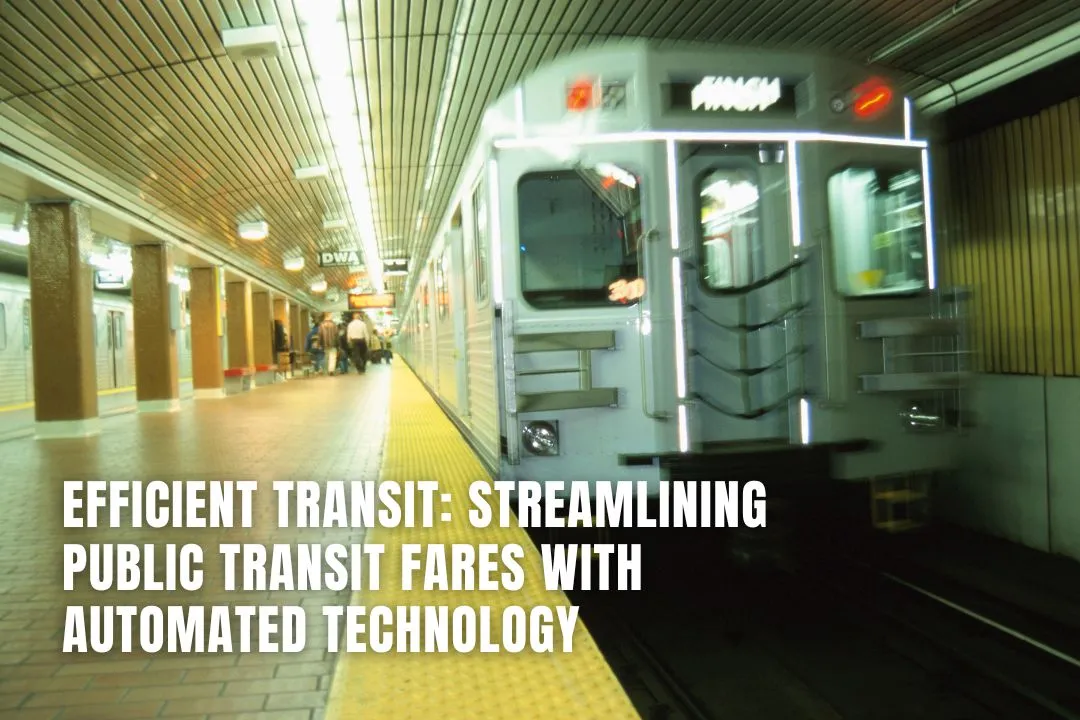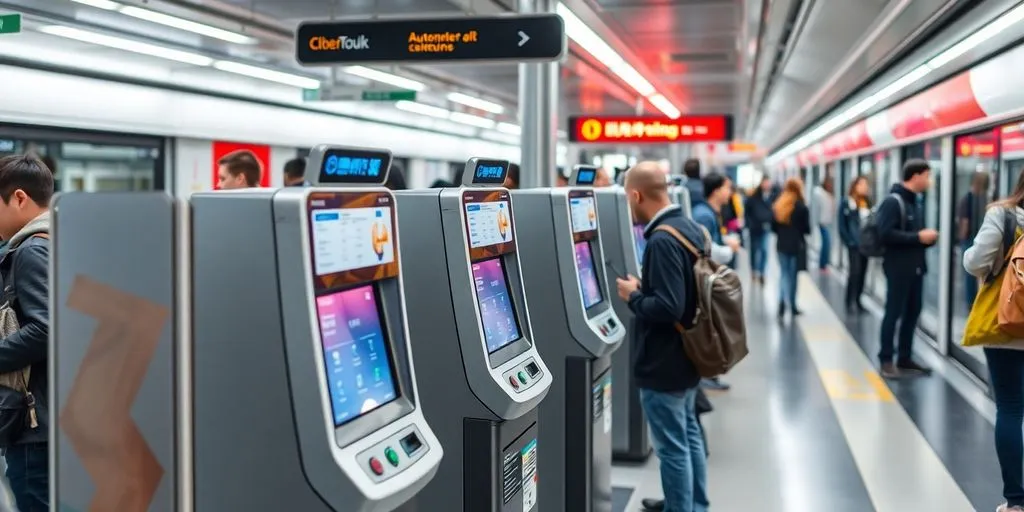Efficient Transit: Streamlining Public Transit Fares with Automated Technology
November 7, 2024

Public transit is essential for many people, but collecting fares can be complicated and slow. Automated Fare Collection (AFC) systems are changing this by making it easier and faster for riders to pay their fares. By using technology, transit agencies can improve their services and make riding public transport a better experience for everyone.
Key Takeaways on Automations in Public Transit
- Automation in fare collection improves efficiency: AFC systems streamline fare payments, reducing delays and errors in transit operations by automating the entire process.
- Faster boarding for passengers: With AFC, passengers can board faster, helping public transit systems stay on schedule and reduce overcrowding at entry points.
- Better passenger experience: Using mobile wallets or contactless bank cards for payments enhances convenience, allowing riders to avoid long queues and unnecessary ticket purchases.
- Cost savings for transit agencies: While AFC systems require upfront investments, they result in long-term savings by cutting down on labor and maintenance costs, as well as reducing the risk of theft.
- Real-time data improves service decisions: AFC systems provide valuable data that can be analyzed to optimize schedules, routes, and services based on passenger demand.
- Integration with existing systems can be challenging: Implementing AFC may involve difficulties in integrating new technology with legacy systems, requiring careful planning and investment in compatible solutions.
- Security and privacy are crucial: As AFC systems handle sensitive passenger data, transit agencies must prioritize cybersecurity measures and ensure that data privacy standards are maintained.
Register Your LLC
Company Registration
START NOWThe Role of Automated Fare Collection in Modern Transit Systems
Automated Fare Collection (AFC) systems are changing how public transit operates. These systems help transit agencies run more smoothly and efficiently. By using technology to manage fare collection, they reduce the need for cash handling and manual ticketing, which can lead to mistakes and delays.
Enhancing Operational Efficiency
- AFC systems speed up the boarding process, allowing buses and trains to stay on schedule.
- They minimize human error by automating fare collection, which means fewer mistakes in transactions.
- With real-time data, transit agencies can quickly adjust services based on passenger demand.
Improving Passenger Experience
- Passengers can enjoy a faster and more convenient way to pay for their rides, often using contactless cards or mobile apps.
- The elimination of cash transactions means less waiting in line to buy tickets.
- Riders appreciate the ease of using their regular bank cards instead of special transit cards.
Reducing Operational Costs
- Although setting up an AFC system requires an initial investment, it leads to long-term savings by cutting down on labor costs.
- Transit agencies spend less on maintaining traditional fare collection machines.
- By reducing cash handling, they also lower the risk of theft and loss.
Implementing an AFC system not only streamlines fare collection but also enhances the overall efficiency of public transit systems, making them more user-friendly and cost-effective.
In summary, Automated Fare Collection systems play a crucial role in modern transit by improving efficiency, enhancing the passenger experience, and reducing costs. They represent a significant step forward in making public transportation more accessible and reliable.
Key Components of Automated Fare Collection Systems
Automated Fare Collection (AFC) systems are essential for modern public transit. They consist of several key components that work together to make fare collection easier and more efficient. These systems use the latest technologies like contactless cards, NFC, and biometrics, which provide quick and secure transaction capabilities.
Contactless Payment Technologies
- Smartcards: Passengers can load money onto these cards and tap them at entry and exit points.
- Mobile Wallets: Smartphones can be used as digital tickets, allowing for easy access to transit services.
- Contactless Bank Cards: Passengers can use their regular debit or credit cards to pay for fares without needing a special transit card.
Fare Validators and Gates
- Turnstiles: Commonly found in metro stations, these devices read fare media and allow entry.
- Handheld Validators: Transit staff can use these devices to check fares on buses or trains.
- Automated Gates: These gates enhance security and streamline the boarding process for passengers.
Centralized Fare Management
- Data Processing: The central system calculates fares and processes transactions in real-time.
- Revenue Tracking: It logs every transaction, helping to prevent fare evasion and ensuring accurate revenue collection.
- Performance Analysis: Transit agencies can analyze data to improve services and understand passenger behavior.
The integration of these components creates a seamless experience for both transit agencies and passengers, making travel easier and more efficient.
Benefits of Streamlining Public Transit Fares
Convenience for Riders
Automated Fare Collection (AFC) systems make it easier for passengers to pay their fares. Riders can use their own credit or debit cards or smartphones, which means they don’t have to learn a new system. This leads to a more seamless and convenient experience when traveling on public transportation, ultimately increasing ridership and revenues.
Increased Revenue Protection
By using AFC, transit agencies can better track fare payments. This helps prevent fare evasion and ensures that all riders pay their fair share. With better tracking, agencies can also identify trends in ridership and adjust services accordingly, leading to more efficient operations.
Data-Driven Insights
AFC systems collect valuable data on passenger behavior. This information can be used to improve services, such as adjusting bus schedules or routes based on demand. Agencies can analyze this data to make informed decisions that enhance the overall transit experience.
Streamlining public transit fares through automated systems not only benefits riders but also helps agencies operate more efficiently and effectively.
In summary, the benefits of streamlining public transit fares through automated technology are clear. It enhances convenience for riders, protects revenue, and provides insights that can lead to better transit services.
Challenges in Implementing Automated Fare Collection

Despite the many advantages of automated fare collection (AFC) systems, there are several challenges that transit agencies face when implementing these technologies.
Initial Setup Costs
One of the biggest hurdles is the initial setup costs. This includes expenses for:
- Fare validators
- Software updates
- Ensuring compatibility with existing infrastructure
While these costs can be high, they are often balanced out by long-term savings.
Integration with Legacy Systems
Many transit agencies already have older fare collection systems in place. Integrating a new AFC system with these legacy systems can be complicated. Key issues include:
- Ensuring compatibility between old and new systems
- Smooth data transfer
- Technical challenges that may arise during integration
Ensuring Data Privacy
AFC systems collect a lot of passenger data, making data privacy a major concern. Transit agencies must invest in:
- Strong cybersecurity measures
- Regular audits to ensure data protection
- Clear policies on data usage and storage
Implementing an AFC system can greatly improve efficiency, but agencies must carefully navigate these challenges to ensure a successful transition.
Maintenance and Upgrades
Once an AFC system is operational, ongoing maintenance and software upgrades are necessary. Agencies need to budget for:
- Regular system checks
- Updates to software and hardware
- Training for staff to handle new technologies
By addressing these challenges, transit agencies can better prepare for the successful implementation of automated fare collection systems, ultimately leading to improved service for passengers and enhanced operational efficiency.
Future Trends in Automated Fare Collection

Adoption of Cloud-Based Solutions
The future of automated fare collection (AFC) is leaning towards cloud-based solutions. These systems allow for easier updates and maintenance, reducing the need for extensive on-site hardware. With cloud technology, transit agencies can manage their fare systems more efficiently and respond quickly to changes in demand.
Integration with Mobility as a Service (MaaS)
As cities evolve, the integration of AFC with Mobility as a Service (MaaS) is becoming crucial. This means that users can plan, book, and pay for various transport options all in one place. This trend will make public transit more user-friendly and accessible, encouraging more people to use it.
Advancements in Security Measures
With the increase in digital transactions, security measures are more important than ever. Future AFC systems will likely incorporate advanced security features to protect user data and prevent fraud. This includes encryption and real-time monitoring to ensure safe transactions.
The shift towards automated fare collection is not just about technology; it's about creating a better experience for everyone who uses public transit.
In summary, the future of automated fare collection is bright, with trends focusing on cloud solutions, integration with MaaS, and enhanced security. These developments will help transit systems become more efficient and user-friendly, ultimately benefiting both agencies and riders.
Case Studies: Successful Implementation of AFC Systems
Urban Transit Networks
Many urban transit networks have successfully adopted Automated Fare Collection (AFC) systems. These systems have transformed how cities manage public transport. For example, cities like New York and London have integrated contactless payment options, allowing passengers to use their smartphones or contactless cards. This has led to:
- Faster boarding times
- Reduced queues at ticket counters
- Enhanced data collection for better service planning
Regional Transportation Systems
Regional transit systems have also benefited from AFC. In cities like San Francisco, the Bay Area Rapid Transit (BART) system implemented AFC to streamline fare collection. The results include:
- Increased revenue protection by minimizing fare evasion
- Improved passenger experience with easy fare options
- Real-time data analytics for better operational decisions
International Examples
Globally, cities like Singapore and Hong Kong have set benchmarks in AFC implementation. These cities have:
- Integrated multiple transport modes into a single payment system.
- Used advanced technologies like mobile wallets and smart cards.
- Achieved high user adoption rates through effective communication strategies.
Implementing AFC systems not only enhances efficiency but also improves the overall experience for passengers, making public transit more appealing.
By examining these case studies, it is clear that AFC systems play a crucial role in modernizing public transit and enhancing operational efficiency.
Conclusion
In summary, using automated technology to manage public transit fares can greatly improve the way we travel. By adopting systems like Automated Fare Collection (AFC), transit agencies can make fare payments easier and faster for everyone. This not only helps riders enjoy a smoother experience but also helps transit agencies save money and operate more efficiently. As cities grow and more people rely on public transportation, it's crucial for agencies to keep up with these changes. Embracing new technology will not only attract more riders but also ensure that public transit remains a reliable option for everyone.
Frequently Asked Questions
What is Automated Fare Collection (AFC)?
Automated Fare Collection (AFC) is a system that allows passengers to pay for their transit rides using technology like contactless cards or mobile apps, making it easier and faster to board.
How does AFC improve the public transit experience?
AFC makes it simpler for riders by letting them use their own cards or phones to pay. This cuts down on wait times and helps everyone get on and off vehicles more quickly.
What are the main benefits of using AFC systems?
The main benefits include faster boarding, less cash handling, better tracking of fare payments, and more convenient options for passengers.
What challenges do transit agencies face when implementing AFC?
Transit agencies often deal with high setup costs, the need to update old systems, and making sure that passenger data is kept safe.
How can AFC systems help transit agencies save money?
By reducing the need for cash handling and improving fare collection, AFC systems can lower operational costs over time, even if the initial setup is expensive.
What future trends should we expect in AFC technology?
Future trends include more use of cloud-based systems, better integration with other transport services, and stronger security measures to protect passenger data.

